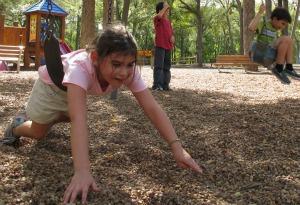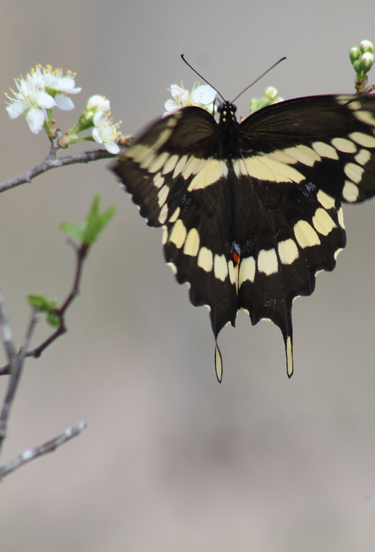The Growing Culture of Nature Play


The importance of nature-based play has gradually become forefront in an array of research fields. From the more obvious physical benefits to the complex mental benefits, nature has proved time and again to be the cure-all for a variety of common ailments. Doctors are even beginning to prescribe nature as a alternative to children and adults. Richard Louv, author of the famed “Last Child in the Woods,” has spawned a growing culture of activists devoted to helping their communities re-learn how to play outside. At the San Antonio Zoo, you will find an entire exhibit dedicated to this very notion. Since Kronkosky’s Tiny Tot Nature Spot opened in 2004, we have been working towards a single goal of helping families with young children “Grow with Nature.” Last April the Zoo even held a community-wide event focused solely on this purpose, called “Get OUT and PLAY Day.” Armed with the muscle of the Texas Children in Nature Network, the San Antonio Zoo brought together 15 organizations and more than 100 non-zoo volunteers from across the city that are all working towards the same goal of getting families outside.
Playing outside used to be the norm for kids regardless of where or how they lived; today is another story. Ecophobia has increasingly become one of the more common fears amongst today’s children, a direct result from not having that vital interaction with nature. From reduced access, to an emerging culture of fear, to an increased activity schedule, there are a variety of explanations for this loss of free play in children. Many children grow up in neighborhoods that are legitimately unsafe for children to play in due to violence or environmental hazards. We have also greatly reduced the amount of natural space available to our children. Children today are more likely to know what a river looks like from seeing it on television as opposed to actually splashing in one. Then of course some of us feel the pressure to believe that children will only succeed if they take advantage of every possible structured learning experience, starting at age three. Many parents worry that they are failing as a caregiver if they do not offer their children these possibilities. Even in school systems, children’s recess and free play has been downsized to make room for additional academic work.
What many fail to realize, is that some aspects of what is expected to be gained from traditional school work can also be gained from nature play. All creatures, children included, learn from play. We are hard-wired to climb rocks, splash in puddles, and roll down hills. Nature provides infinite possibilities for kids to grow and learn, allowing their play to be more diverse and fostering language and collaborative skills. Nature play not only helps children develop powers of observation and creativity, it also helps them deal with stress and adversity, and enables them to concentrate better. Children allowed to regularly play in natural environments have increased coordination, balance, and agility. On top of the physical and mental benefits of playing outside, children also cultivate an emotional connection with the world around them. It is this connection that is so vital to developing a sense of wonder, which eminent biologist E.O. Wilson points out is an important motivator for lifelong learning.
Unfortunately fear is helping bred helicopter moms. You all know her; she hovers closely, stopping her child from digging in the dirt and scolding them for getting their feet wet. So what can we do? The San Antonio Zoo is attempting to re-create the curious child by helping parents release that control. Kronkosky’s Tiny Tot Nature Spot has the sole purpose of helping families with young children “Grow with Nature.” Specially trained staff, called Playleaders, model nature play by leading activities with guests. By playing with the child in the natural substrate, Playleaders demonstrate not only the benefits to the child, but to the parent as well. This is important because studies show having an active family role model engage young children in positive nature experiences to be one of the primary factors for developing a conservation-minded adult. By incorporating the parents in the activities, the Nature Spot helps generate this positive nature connection between parent and child. Without these early experiences, it is likely children won’t grow to value the natural world and protect it as they get older.
Like many states, Texas has both state and regional children in nature initiatives. One easy way our regional collaborative made a difference was through the creation of Get Out and Play Day. This community-wide zoo event brought together children in nature member organizations and various local companies that promote nature-based play. By combining Get Out and Play Day with a local university’s Play Conference, Texas Children in Nature Partnership’s spring events, and the Children and Nature Network’s “Let’s Go” events, the Zoo not only gained 60+ well-trained play volunteers, we also had a much higher profile event. Over 20 activity stations were set up throughout the Zoo and were manned by both Zoo staff/volunteers and over a dozen outside organizations. Activities reflected the organization’s site or mission and were all focused on helping families play in nature. Stations included activities such as fishing, an archeological dig, gardening, and story time. With over 7,000 Zoo visitors that day, evaluation efforts showed an overwhelmingly positive reaction to the event and nature-based play overall.
The number of physical, mental, and emotional benefits nature play offers are seemingly limitless. Where families are not comfortable in or have access to nature, the San Antonio Zoo is able to provide those outdoor opportunities. From exhibit design, to specialized staff, to creative activities, Kronkosky’s Tiny Tot Nature Spot continues to grow budding naturalists. By combining our efforts with those of our community partners during Get OUT and PLAY Day, we were able to capitalize on the knowledge of those partners without having to rely solely on Zoo resources. It is these partnerships that have enabled us to impact a greater audience to become healthier, happier, and smarter by playing outside.







